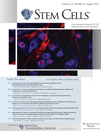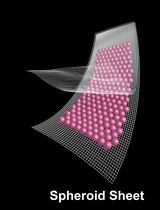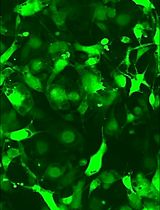- EN - English
- CN - 中文
Analysis of Mitochondrial Transfer in Direct Co-cultures of Human Monocyte-derived Macrophages (MDM) and Mesenchymal Stem Cells (MSC)
利用细胞源性巨噬细胞(MDM)和间充质干细胞(MSC)共培养体系分析细胞间线粒体的转移
发布: 2017年05月05日第7卷第9期 DOI: 10.21769/BioProtoc.2255 浏览次数: 14658
评审: Anonymous reviewer(s)

相关实验方案

研究免疫调控血管功能的新实验方法:小鼠主动脉与T淋巴细胞或巨噬细胞的共培养
Taylor C. Kress [...] Eric J. Belin de Chantemèle
2025年09月05日 3445 阅读
Abstract
Mesenchymal stem/stromal cells (MSC) are adult stem cells which have been shown to improve survival, enhance bacterial clearance and alleviate inflammation in pre-clinical models of acute respiratory distress syndrome (ARDS) and sepsis. These diseases are characterised by uncontrolled inflammation often underpinned by bacterial infection. The mechanisms of MSC immunomodulatory effects are not fully understood yet. We sought to investigate MSC cell contact-dependent communication with alveolar macrophages (AM), professional phagocytes which play an important role in the lung inflammatory responses and anti-bacterial defence. With the use of a basic direct co-culture system, confocal microscopy and flow cytometry we visualised and effectively quantified MSC mitochondrial transfer to AM through tunnelling nanotubes (TNT). To model the human AM, primary monocytes were isolated from human donor blood and differentiated into macrophages (monocyte derived macrophages, MDM) in the presence of granulocyte macrophage colony-stimulating factor (GM-CSF), thus allowing adaptation of an AM-like phenotype (de Almeida et al., 2000; Guilliams et al., 2013). Human bone-marrow derived MSC, were labelled with mitochondria-specific fluorescent stain, washed extensively, seeded into the tissue culture plate with MDMs at the ratio of 1:20 (MSC/MDM) and co-cultured for 24 h. TNT formation and mitochondrial transfer were visualised by confocal microscopy and semi-quantified by flow cytometry. By using the method we described here we established that MSC use TNTs as the means to transfer mitochondria to macrophages. Further studies demonstrated that mitochondrial transfer enhances macrophage oxidative phosphorylation and phagocytosis. When TNT formation was blocked by cytochalasin B, MSC effect on macrophage phagocytosis was completely abrogated. This is the first study to demonstrate TNT-mediated mitochondrial transfer from MSC to innate immune cells.
Keywords: Mesenchymal stem cells (间充质干细胞)Background
Data from pre-clinical studies, including studies by our group (Xu et al., 2007 and 2008; Nemeth et al., 2009; Gupta et al., 2007 and 2012; Krasnodembskaya et al., 2010 and 2012; Mei et al., 2010; Lee et al., 2013; Jackson et al., 2016) demonstrated strong potential for MSC as a future cell-based therapy for the treatment of ARDS, an injurious hyper-inflammatory condition of the lung. In these studies MSC have displayed regenerative, immune-modulatory and anti-microbial effects which have consequently provided rationale for the design of phase I and phase II clinical trials for MSC in ARDS (Zheng et al., 2014; Wilson et al., 2015). However, despite the rapid translation of MSC into the clinical trials, mechanisms of how MSC alleviate symptoms of ARDS still need to be fully elucidated. Recent studies have reported MSC modulate lung epithelial and endothelial cells through mitochondrial transfer via TNTs, resulting in improvement of the host cell bioenergetics (Islam et al., 2012; Ahmad et al., 2014; Li et al., 2014; Liu et al., 2014). In ARDS, excessive pulmonary inflammation is one of the main characteristics of the disease in which alveolar macrophages (AM) are prominent cells. They orchestrate the inflammatory responses in the alveoli and play an important role in the lung bacterial clearance (Ware and Matthay, 2000; Jackson et al., 2016).
This protocol allowed us to study the functional effects of a TNT mediated process of an organelle transfer between MDMs both in vitro and using the same staining protocol, mouse alveolar macrophages in vivo (Jackson et al., 2016). Although the major focus of our study was mitochondrial transfer, this protocol can be adapted with slight modifications for investigations of transfer of other organelles or even fluorescently labelled molecules.
Materials and Reagents
- Extraction of mononuclear cells from human donor Buffy Coats
- 50 ml Falcon tubes (SARSTEDT, catalog number: 62.554.502 )
- T175 culture flasks (Thermo Fisher Scientific, Thermo ScientificTM, catalog number: 178883 )
- Sterile Pasteur pipettes (BIOLOGIX GROUP LTD Technical, catalog number: 30-0138A1 )
- Cover slip
- Tissue culture coated 6 well plate (Thermo Fisher Scientific, Thermo ScientificTM, catalog numbers: 140675 )
- Buffy coats are obtained from the Northern Ireland Blood Transfusion Service (NIBTS) following ethical approval by the School Research Ethics Committee of Queen’s University Belfast
- Hank’s buffered salt solution (HBSS) No Ca2+ or Mg2+ (Thermo Fisher Scientific, catalog number: 14170138 )
- Ficoll-Paque (GE Healthcare, catalog number: 17-5442-03 )
- Complete RPMI 1640 (Thermo Fisher Scientific, GibcoTM, catalog number: 21875034 )
- Foetal calf serum (FCS) (heat inactivated) (Thermo Fisher Scientific, GibcoTM, catalog number: 10270106 )
- Granulocyte-macrophage colony stimulating factor (GM-CSF) (PeproTech, catalog number: 300-03 )
- Penicillin/streptomycin 10,000 U/ml (Thermo Fisher Scientific, GibcoTM, catalog number: 15140122 )
- Trypan blue (Thermo Fisher Scientific, GibcoTM, catalog number: 15250061 )
- Complete 1% FBS RPMI (see Recipes)
- Complete RPMIGM-CSF (see Recipes)
- 50 ml Falcon tubes (SARSTEDT, catalog number: 62.554.502 )
- Culture of human bone marrow-derived mesenchymal stromal cells (MSC)
- 50 ml Falcon tubes (SARSTEDT, catalog number: 62.554.502 )
- 8-well chamber slides (Sigma-Aldrich, catalog number: C7182 )
- Tissue culture coated 6-well and 24-well plates (Thermo Fisher Scientific, Thermo ScientificTM, catalog numbers: 140675 , 142475 )
- Pechiney PM999 Parafilm (Bemis, catalog number: PM999 )
- Microscope slide
- Sterile Eppendorf tubes (SARSTEDT, catalog number: 72.690.001 )
- Flow tubes (SARSTEDT, catalog number: 55.475 )
- Human bone marrow-derived MSCs are obtained from the NIH repository in Texas A&M Health Science Centre College of Medicine, Institute for Regenerative Medicine (Temple, Texas). The cells meet all the criteria for the classification as MSCs as defined by the International Society of Cellular Therapy (Dominici et al., 2006)
- Liquid nitrogen
- Dulbecco’s phosphate buffered saline (DPBS) (Thermo Fisher Scientific, GibcoTM, catalog number: 14190094 )
- Complete α-MEM (Thermo Fisher Scientific, GibcoTM, catalog number: 22561021 )
- Penicillin/streptomycin 10,000 U/ml (Thermo Fisher Scientific, GibcoTM, catalog number: 15140122 )
- L-glutamine (Thermo Fisher Scientific, GibcoTM, catalog number: 25030024 )
- Cytochalasin B (Sigma-Aldrich, catalog number: C6762 )
- 10x trypsin (Thermo Fisher Scientific, GibcoTM, catalog number: 15250061 )
- Foetal calf serum (FCS) (heat inactivated) (Thermo Fisher Scientific, GibcoTM, catalog number: 10270106 )
- Trypan blue (Thermo Fisher Scientific, GibcoTM, catalog number: 15250061 )
- MitoTracker Deep Red FM probe (APC) (Thermo Fisher Scientific, Molecular ProbesTM, catalog number: M22426 )
- Dimethyl sulfoxide (DMSO) (Sigma-Aldrich, catalog number: D8418 )
- Complete α-MEM (see Recipes)
- Mitochondrial staining solution (1% FBS α-MEM1%MITO) (see Recipes)
- Cytochalasin B solution (1%FBS α-MEM1%CYTO) (see Recipes)
- 50 ml Falcon tubes (SARSTEDT, catalog number: 62.554.502 )
- Confocal microscopy
- 0.45 µm filter membrane (SARSTEDT, catalog number: 83.1826.001 )
- Pechiney PM999 Parafilm (Bemis, catalog number: PM999 )
- Paper towel
- Microscope slide
- Coverslip
- Phosphate buffered saline (PBS) (Thermo Fisher Scientific, GibcoTM, catalog number: 10010023 )
- Paraformaldehyde (PFA) (Sigma-Aldrich, catalog number: 158127 )
- 1 N NaOH (Sigma-Aldrich, catalog number: S2770 )
- 1 N HCl (Sigma-Aldrich, catalog number: H9892 )
- Normal goat serum (NGS) (Thermo Fisher Scientific, Invitrogen, catalog number: 31872 )
- Mouse anti-human CD45 primary antibody (Abcam, catalog number: ab8216 )
- Mouse IgG1 isotype (Abcam, catalog number: ab81032 )
- Goat anti-rabbit Alexafluor 405 secondary antibody (Abcam, catalog number: ab175655 )
- Brightmount/Plus aqueous mounting medium (Abcam, catalog number: ab103748 )
- Nail varnish
- 1% FBS PBS (see Recipes)
- 4% paraformaldehyde (PFA) (see Recipes)
- Strong and weak block for immunofluorescent staining (see Recipes)
- 0.45 µm filter membrane (SARSTEDT, catalog number: 83.1826.001 )
- Flow cytometry
- Cell scrapers (Fisher Scientific, catalog number: 08-100-241 )
- Sarstedt 5 ml polystyrene round bottomed flow tubes (SARSTEDT, catalog number: 55.1578 )
- Phosphate buffered saline (PBS) (Thermo Fisher Scientific, GibcoTM, catalog number: 10010023 )
- Human FcR binding inhibitor (Thermo Fisher Scientific, eBioscienceTM, catalog number: 14-9161-73 )
- Anti-human CD45 (PE) antibody (Thermo Fisher Scientific, eBioscienceTM, catalog number: 12-9459-41 )
- Isotype control (IgG1 kappa) (Thermo Fisher Scientific, eBioscienceTM, catalog number: 12-4714 )
- Zombie Aqua Fixable Dye (BioLegend, catalog number: 423101 )
- Cell scrapers (Fisher Scientific, catalog number: 08-100-241 )
- Bacterial culture and phagocytosis assay
- Escherichia coli K1 type strain
- Phosphate buffered saline (PBS) (Thermo Fisher Scientific, GibcoTM, catalog number: 10010023 )
- LB broth (Lennox) (Sigma-Aldrich, catalog number: L3022 )
- LB broth with agar (Lennox) (Sigma-Aldrich, catalog number: L2897 )
- Hank’s buffered salt solution (HBSS) No Ca2+ or Mg2+ (Thermo Fisher Scientific, catalog number: 14170138 )
- Complete RPMI 1640 (Thermo Fisher Scientific, GibcoTM, catalog number: 21875034 )
- Saponin (Sigma-Aldrich, catalog number: 47036 )
- Gentamycin (Sigma-Aldrich, catalog number: G1397 )
- Complete 1% FBS RPMI (see Recipes)
- 0.5% saponin (see Recipes)
- Escherichia coli K1 type strain
Equipment
- Water bath (37 °C) (Grant Instruments, model: JBN12 )
- Centrifuge (Eppendorf, model: 5810 R )
- Laminar flow cabinet (Contained Air Solutions, model: BioMAT 2 safety cabinet class 2 )
- Haemocytometer and cover slips (Hawksley Medical and Laboratory Equipment, model: AC1000 Improved Neubauer , catalog number: BS 748)
- Incubator (Panasonic Biomedical, model: MCO-170AIC-PE )
- Dmi1 microscope (Leica Microsystems, model: DMi1 )
- TCS SP5 II Leica confocal microscope (Leica Microsystems, model: TCS SP5 II )
- BD FACSCanto II Flow cytometer (BD, model: BD FACSCanto II )
- Vortex (Cole-Palmer Instrument, catalog number: UY-86579-20 )
- 2-20 µl pipette (Gilson, catalog number: F123600 )
- 20-200 µl pipette (Gilson, catalog number: F144565 )
- 100-1,000 µl pipette (Gilson, catalog number: F144566 )
- Midi PlusTM pipette controller Automatic (Sartorius, catalog number: 710931 )
Software
- FlowJo software (FlowJo)
- Prism 5 software (GraphPad Software)
- LAS-AF software (Leica confocal microscopy)
- FACS DIVA software (flow cytometry)
Procedure
文章信息
版权信息
© 2017 The Authors; exclusive licensee Bio-protocol LLC.
如何引用
Jackson, M. V. and Krasnodembskaya, A. D. (2017). Analysis of Mitochondrial Transfer in Direct Co-cultures of Human Monocyte-derived Macrophages (MDM) and Mesenchymal Stem Cells (MSC). Bio-protocol 7(9): e2255. DOI: 10.21769/BioProtoc.2255.
分类
干细胞 > 成体干细胞 > 间充质干细胞
免疫学 > 免疫细胞功能 > 巨噬细胞
细胞生物学 > 基于细胞的分析方法 > 转运
您对这篇实验方法有问题吗?
在此处发布您的问题,我们将邀请本文作者来回答。同时,我们会将您的问题发布到Bio-protocol Exchange,以便寻求社区成员的帮助。
Share
Bluesky
X
Copy link



.jpg)









